Clinical Pattern of Preoperative Positron Emission Tomography/Computed Tomography (PET/CT) Can Predict the Aggressive Behavior of Resected Solid Pseudopapillary Neoplasm of the Pancreas
Abstract
Simple Summary
Abstract
1. Introduction
2. Materials and Methods
2.1. Definition of Terms
2.2. Data Collection
2.3. Statistical Analysis of Baseline Characteristics
3. Results
3.1. General Patient Data
3.2. Preoperative Evaluation
3.3. Surgical Outcomes
3.4. Patients with Aggressive Neoplasm
3.5. Factors Affecting Aggressive Behavior
4. Discussion
5. Conclusions
Supplementary Materials
Author Contributions
Funding
Institutional Review Board Statement
Informed Consent Statement
Data Availability Statement
Conflicts of Interest
References
- Watanabe, Y.; Okamoto, K.; Okada, K.; Aikawa, M.; Koyama, I.; Yamaguchi, H. A case of aggressive solid pseudopapillary neoplasm: Comparison of clinical and pathologic features with non-aggressive cases. Pathol. Int. 2017, 67, 202–207. [Google Scholar] [CrossRef]
- Martin, R.C.; Klimstra, D.S.; Brennan, M.F.; Conlon, K.C. Solid-pseudopapillary tumor of the pancreas: A surgical enigma? Ann. Surg. Oncol. 2002, 9, 35–40. [Google Scholar] [CrossRef] [PubMed]
- Bhutani, N.; Kajal, P.; Singla, S.; Sangwan, V. Solid pseudopapillary tumor of the pancreas: Experience at a tertiary care centre of northern india. Int. J. Surg. Case Rep. 2017, 39, 225–230. [Google Scholar] [CrossRef] [PubMed]
- Hanada, K.; Kurihara, K.; Itoi, T.; Katanuma, A.; Sasaki, T.; Hara, K.; Nakamura, M.; Kimura, W.; Suzuki, Y.; Sugiyama, M.; et al. Clinical and pathological features of solid pseudopapillary neoplasms of the pancreas: A nationwide multicenter study in japan. Pancreas 2018, 47, 1019–1026. [Google Scholar] [CrossRef] [PubMed]
- Kang, C.M.; Kim, K.S.; Choi, J.S.; Kim, H.; Lee, W.J.; Kim, B.R. Solid pseudopapillary tumor of the pancreas suggesting malignant potential. Pancreas 2006, 32, 276–280. [Google Scholar] [CrossRef] [PubMed]
- Irtan, S.; Galmiche-Rolland, L.; Elie, C.; Orbach, D.; Sauvanet, A.; Elias, D.; Guerin, F.; Coze, C.; Faure-Conter, C.; Becmeur, F.; et al. Recurrence of solid pseudopapillary neoplasms of the pancreas: Results of a nationwide study of risk factors and treatment modalities. Pediatric Blood Cancer 2016, 63, 1515–1521. [Google Scholar] [CrossRef] [PubMed]
- Lin, M.Y.; Stabile, B.E. Solid pseudopapillary neoplasm of the pancreas: A rare and atypically aggressive disease among male patients. Am. Surg. 2010, 76, 1075–1078. [Google Scholar] [CrossRef]
- Yang, F.; Bao, Y.; Zhou, Z.; Jin, C.; Fu, D. Preoperative neutrophil-to-lymphocyte ratio predicts malignancy and recurrence-free survival of solid pseudopapillary tumor of the pancreas. J. Surg. Oncol. 2019, 120, 241–248. [Google Scholar] [CrossRef]
- Park, S.E.; Park, N.S.; Chun, J.M.; Park, N.W.; Yang, Y.J.; Yun, G.W.; Lee, H.J.; Yun, H.J.; Jo, D.Y.; Song, K.S.; et al. A case of recurrent solid pseudopapillary tumor of the pancreas with involvement of the spleen and kidney. Cancer Res. Treat. Off. J. Korean Cancer Assoc. 2006, 38, 118–120. [Google Scholar] [CrossRef]
- Kang, C.M.; Choi, S.H.; Kim, S.C.; Lee, W.J.; Choi, D.W.; Kim, S.W. Predicting recurrence of pancreatic solid pseudopapillary tumors after surgical resection: A multicenter analysis in korea. Ann. Surg. 2014, 260, 348–355. [Google Scholar] [CrossRef]
- Lubezky, N.; Papoulas, M.; Lessing, Y.; Gitstein, G.; Brazowski, E.; Nachmany, I.; Lahat, G.; Goykhman, Y.; Ben-Yehuda, A.; Nakache, R.; et al. Solid pseudopapillary neoplasm of the pancreas: Management and long-term outcome. Eur. J. Surg. Oncol. J. Eur. Soc. Surg. Oncol. Br. Assoc. Surg. Oncol. 2017, 43, 1056–1060. [Google Scholar] [CrossRef] [PubMed]
- Tang, L.H.; Aydin, H.; Brennan, M.F.; Klimstra, D.S. Clinically aggressive solid pseudopapillary tumors of the pancreas: A report of two cases with components of undifferentiated carcinoma and a comparative clinicopathologic analysis of 34 conventional cases. Am. J. Surg. Pathol. 2005, 29, 512–519. [Google Scholar] [CrossRef] [PubMed]
- Xu, Y.; Zhao, G.; Pu, N.; Nuerxiati, A.; Ji, Y.; Zhang, L.; Rong, Y.; Lou, W.; Wang, D.; Kuang, T.; et al. One hundred twenty-one resected solid pseudopapillary tumors of the pancreas: An 8-year single-institution experience at zhongshan hospital, shanghai, china. Pancreas 2017, 46, 1023–1028. [Google Scholar] [CrossRef] [PubMed]
- Yang, F.; Yu, X.; Bao, Y.; Du, Z.; Jin, C.; Fu, D. Prognostic value of ki-67 in solid pseudopapillary tumor of the pancreas: Huashan experience and systematic review of the literature. Surgery 2016, 159, 1023–1031. [Google Scholar] [CrossRef]
- Kim, J.H.; Lee, J.M. Clinicopathologic review of 31 cases of solid pseudopapillary pancreatic tumors: Can we use the scoring system of microscopic features for suggesting clinically malignant potential? Am. Surg. 2016, 82, 308–313. [Google Scholar] [CrossRef] [PubMed]
- Sperti, C.; Berselli, M.; Pasquali, C.; Pastorelli, D.; Pedrazzoli, S. Aggressive behaviour of solid-pseudopapillary tumor of the pancreas in adults: A case report and review of the literature. World J. Gastroenterol. 2008, 14, 960–965. [Google Scholar] [CrossRef]
- Kang, C.M.; Cho, A.; Kim, H.; Chung, Y.E.; Hwang, H.K.; Choi, S.H.; Lee, W.J. Clinical correlations with (18)fdg pet scan patterns in solid pseudopapillary tumors of the pancreas: Still a surgical enigma? Pancreatol. Off. J. Int. Assoc. Pancreatol. 2014, 14, 515–523. [Google Scholar] [CrossRef]
- Nakagohri, T.; Kinoshita, T.; Konishi, M.; Takahashi, S.; Gotohda, N. Surgical outcome of solid pseudopapillary tumor of the pancreas. J. Hepato-Biliary-Pancreat. Surg. 2008, 15, 318–321. [Google Scholar] [CrossRef] [PubMed]
- Kim, Y.I.; Kim, S.K.; Paeng, J.C.; Lee, H.Y. Comparison of f-18-fdg pet/ct findings between pancreatic solid pseudopapillary tumor and pancreatic ductal adenocarcinoma. Eur. J. Radiol. 2014, 83, 231–235. [Google Scholar] [CrossRef]
- Dong, A.; Wang, Y.; Dong, H.; Zhang, J.; Cheng, C.; Zuo, C. Fdg pet/ct findings of solid pseudopapillary tumor of the pancreas with ct and mri correlation. Clin. Nucl. Med. 2013, 38, e118–e124. [Google Scholar] [CrossRef]
- Guan, Z.W.; Xu, B.X.; Wang, R.M.; Sun, L.; Tian, J.H. Hyperaccumulation of (18)f-fdg in order to differentiate solid pseudopapillary tumors from adenocarcinomas and from neuroendocrine pancreatic tumors and review of the literature. Hell. J. Nucl. Med. 2013, 16, 97–102. [Google Scholar] [PubMed]
- Liszka, L.; Mrowiec, S.; Pajak, J.; Kostrzab-Zdebel, A.; Lampe, P.; Kajor, M. Limited usefulness of histopathological features in identification of a clinically aggressive solid-pseudopapillary neoplasm of the pancreas. Pol. J. Pathol. Off. J. Pol. Soc. Pathol. 2014, 65, 182–193. [Google Scholar] [CrossRef] [PubMed]
- Tajima, H.; Takamura, H.; Kitagawa, H.; Nakayama, A.; Shoji, M.; Watanabe, T.; Tsukada, T.; Nakanuma, S.; Okamoto, K.; Sakai, S.; et al. Multiple liver metastases of pancreatic solid pseudopapillary tumor treated with resection following chemotherapy and transcatheter arterial embolization: A case report. Oncol. Lett. 2015, 9, 1733–1738. [Google Scholar] [CrossRef] [PubMed]
- Yang, M.; Ke, N.W.; Zeng, L.; Zhang, Y.; Tan, C.L.; Zhang, H.; Mai, G.; Tian, B.L.; Liu, X.B. Survival analyses for patients with surgically resected pancreatic neuroendocrine tumors by world health organization 2010 grading classifications and american joint committee on cancer 2010 staging systems. Medicine 2015, 94, e2156. [Google Scholar] [CrossRef]
- Yu, P.; Cheng, X.; Du, Y.; Yang, L.; Xu, Z.; Yin, W.; Zhong, Z.; Wang, X.; Xu, H.; Hu, C. Solid pseudopapillary neoplasms of the pancreas: A 19-year multicenter experience in china. J. Gastrointest. Surg. Off. J. Soc. Surg. Aliment. Tract 2015, 19, 1433–1440. [Google Scholar] [CrossRef] [PubMed]
- Sileikis, A.; Nutautiene, V.; Seinin, D.; Strupas, K. Solid pseudopapillary neoplasm of the pancreas: Analysis of seven cases. Viszeralmedizin 2014, 30, 211–215. [Google Scholar] [PubMed]
- Strauss, J.F.; Hirsch, V.J.; Rubey, C.N.; Pollock, M. Resection of a solid and papillary epithelial neoplasm of the pancreas following treatment with cis-platinum and 5-fluorouracil: A case report. Med. Pediatric Oncol. 1993, 21, 365–367. [Google Scholar] [CrossRef]
- Sumida, W.; Kaneko, K.; Tainaka, T.; Ono, Y.; Kiuchi, T.; Ando, H. Liver transplantation for multiple liver metastases from solid pseudopapillary tumor of the pancreas. J. Pediatric Surg. 2007, 42, e27–e31. [Google Scholar] [CrossRef] [PubMed]
- Dindo, D.; Demartines, N.; Clavien, P.A. Classification of surgical complications: A new proposal with evaluation in a cohort of 6336 patients and results of a survey. Ann. Surg. 2004, 240, 205–213. [Google Scholar] [CrossRef]
- Tosun Tasar, P.; Sahin, S.; Akcam, N.O.; Dinckal, C.; Ulusoy, M.G.; Sarikaya, O.F.; Duman, S.; Akcicek, F.; Noyan, A. Delirium is associated with increased mortality in the geriatric population. Int. J. Psychiatry Clin. Pract. 2017. [Google Scholar] [CrossRef] [PubMed]
- Men, K.; Chen, Y.; Zhang, J.; Wei, D. The evaluation of cellular immune function in elderly patients with systemic lupus erythematosus. Korean J. Intern. Med. 2017. [Google Scholar] [CrossRef]
- Gonsoulin, M.E.; Durazo-Arvizu, R.A.; Goldstein, K.M.; Cao, G.; Zhang, Q.; Ramanathan, D.; Hynes, D.M. A health profile of senior-aged women veterans: A latent class analysis of condition clusters. Innov. Aging 2017, 1. [Google Scholar] [CrossRef] [PubMed]
- Park, M.; Hwang, H.K.; Yun, M.; Lee, W.J.; Kim, H.; Kang, C.M. Metabolic characteristics of solid pseudopapillary neoplasms of the pancreas: Their relationships with high intensity (18)f-fdg pet images. Oncotarget 2018, 9, 12009–12019. [Google Scholar] [CrossRef] [PubMed]
- De Robertis, R.; Marchegiani, G.; Catania, M.; Ambrosetti, M.C.; Capelli, P.; Salvia, R.; D’Onofrio, M. Solid pseudopapillary neoplasms of the pancreas: Clinicopathologic and radiologic features according to size. Ajr Am. J. Roentgenol 2019, 213, 1073–1080. [Google Scholar] [CrossRef] [PubMed]
- Reindl, B.A.; Lynch, D.W.; Jassim, A.D. Aggressive variant of a solid pseudopapillary neoplasm: A case report and literature review. Arch. Pathol. Lab. Med. 2014, 138, 974–978. [Google Scholar] [CrossRef]
- Guo, M.; Luo, G.; Jin, K.; Long, J.; Cheng, H.; Lu, Y.; Wang, Z.; Yang, C.; Xu, J.; Ni, Q.; et al. Somatic genetic variation in solid pseudopapillary tumor of the pancreas by whole exome sequencing. Int. J. Mol. Sci. 2017, 18, 81. [Google Scholar] [CrossRef] [PubMed]
- Cohen, S.J.; Papoulas, M.; Graubardt, N.; Ovdat, E.; Loewenstein, S.; Kania-Almog, J.; Pasmanik-Chor, M.; Brazowski, E.; Cagnano, E.; Nachmany, I.; et al. Micro-rna expression patterns predict metastatic spread in solid pseudopapillary neoplasms of the pancreas. Front. Oncol. 2020, 10, 328. [Google Scholar] [CrossRef] [PubMed]
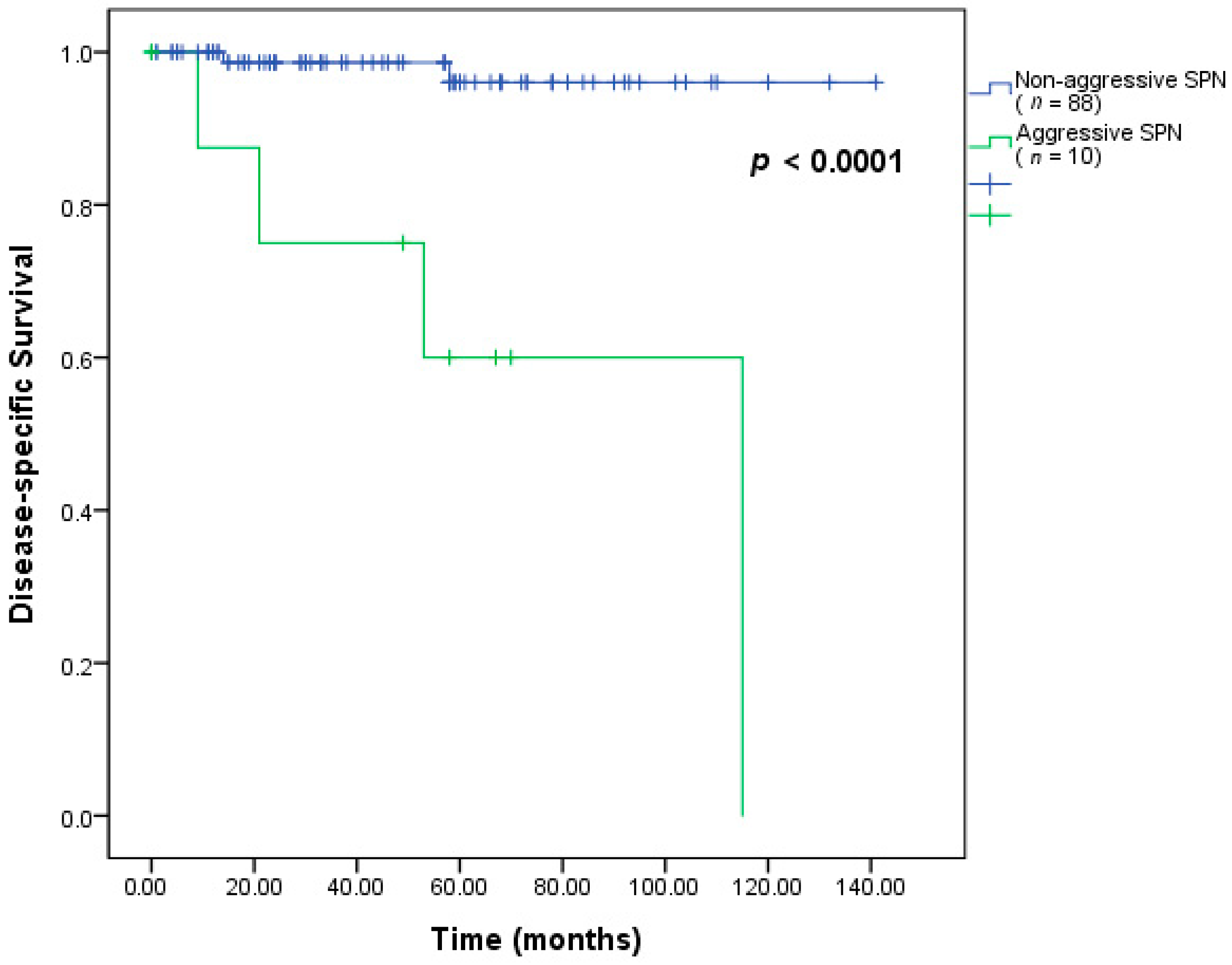
| Variables | No. of Patients (%) |
|---|---|
| Age | 36.03 ± 15.6 |
| Sex (F/M) | 83 (84.7%)/15 (15.3%) |
| BMI | 22.05 ± 3.3 |
| Symptomatic (yes/no) | 42 (42.9%)/56 (57.1%) |
| Abdominal pain | 35 (83.3%) |
| Abdominal mass | 9 (29.4%) |
| Tumor size (cm) | 4.6 ± 2.8 |
| Tumor location (proximal/distal) | 29 (29.6%)/69 (70.4%) |
| Operation type (minimally invasive/open) | 64 (65.3%)/34 (34.7%) |
| Operation | - |
| PPPD | 21 (21.4%) |
| Central pancreatectomy | 9 (9.2%) |
| Distal pancreatectomy | 62 (63.3%) |
| Enucleation | 5 (5.1%) |
| Biopsy | 1 (1.0%) |
| PET/CT Scan Uptake Classification 1 | Scheme | Description | No. of Patients (%) | Representative PET/CT Image |
|---|---|---|---|---|
| Type I |  | Completely hot uptake type, no defect area | 24 (27.9%) | 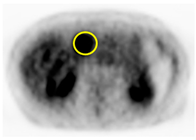 |
| Type II |  | Focal defect area with almost type I background | 18 (20.9%) | 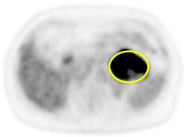 |
| Type III |  | Multiple or geographic uptake with defective background | 23 (26.7%) | 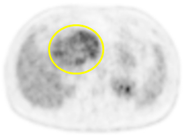 |
| Type IV |  | Focal uptake with mainly defective background | 18 (20.9%) | 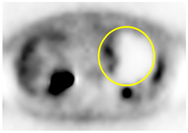 |
| Type V |  | No uptake, completely defective background | 3 (3.5%) | 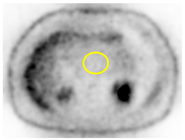 |
| Variables | No. of Patients (%) |
|---|---|
| Disease-specific deaths | 6 (6.1%) |
| R0 resection | 98 (100%) |
| Positive margins | 0 (0%) |
| Microscopic pathology | - |
| Capsular invasion | 24 (24.5%) |
| Lymphovascular invasion | 35 (83.3%) |
| Perineural invasion | 9 (29.4%) |
| Ki-67 | 4.6 ± 2.8 |
| Complication 1 | 29 (29.6%) |
| Clavien–Dindo Class I | 2 (2%) |
| Clavien–Dindo Class II | 15 (15.3%) |
| Clavien–Dindo Class IIIa/IIIb | 7 (7.1%)/3 (3.1%) |
| Clavien–Dindo Class IV/V | 1 (1%)/1 (1%) |
| No. | Age (years) | Sex | Tumor Size (cm) | Symptom | Tumor Location | Type of Operation | Lymphovascular Invasion | Type of Aggressive Behavior | Treatment for Recurrence | Follow-Up Period (Status) |
|---|---|---|---|---|---|---|---|---|---|---|
| 1 | 81 | F | 12 | Abdominal mass | Distal | Distal pancreatectomy | None | Liver metastasis after five months | Conservative treatment | 21 months (Death) |
| 2 | 12 | F | 10.10 | Abdominal mass | Distal | Distal pancreatectomy | None | Liver metastasis after 10 months | Chemotherapy | 115 months (Death) |
| 3 | 46 | F | 2.00 | Incidental | Distal | Distal pancreatectomy | None | Peritoneal metastasis after 37 months | Chemotherapy | 53 months (Death) |
| 4 | 67 | M | 2.5 | Abdominal pain | Distal | Distal pancreatectomy | None | Liver metastasis after 43 months | Chemotherapy | 70 months (Survival) |
| 5 | 45 | F | 11 | Abdominal pain | Distal | Biopsy | None | Liver metastasis after two months | Chemotherapy | Nine months (Death) |
| 6 | 46 | F | 4.3 | Abdominal pain | Proximal | PPPD + metastasectomy | None | Liver metastasis on diagnosis; peritoneal metastasis after 41 months | Chemotherapy | 58 months (Survival) |
| 7 | 68 | F | 5 | Abdominal pain | Proximal | PPPD + right hemicolectomy, PV resection | None | Invading hepatic flexure, portal vein | No recurrence | 0 months (Death) |
| 8 | 52 | M | 11 | Abdominal pain | Proximal | PPPD + right hemicolectomy | None | Invading hepatic flexure | No recurrence | 67 months (Survival) |
| 9 | 10 | F | 6 | Abdominal pain | Distal | Distal pancreatectomy + transverse colectomy | None | Invading transverse colon | No recurrence | 49 months (Survival) |
| 10 | 27 | M | 9.4 | Abdominal mass | Proximal | PPPD + PV resection | None | Invading portal vein | No recurrence | 39 months (Survival) |
| Variables | Aggressive (n = 10) | Non-Aggressive (n = 88) | p-Value | p-Value Exp(β) (95% CI) |
|---|---|---|---|---|
| Age | - | - | - | - |
| ≥40 * | 7 (70%) | 32 (36.4%) | 0.039 | 0.015 23.242 (1.854/291.4) |
| 19–39 | 1 (10%) | 43 (48.9%) | 0.431 | - |
| ≤18 | 2 (20%) | 13 (14.8%) | 0.664 | - |
| Sex (F/M) | 7/3 | 76/12 | 0.173 | - |
| BMI | 21.7 ± 4.74 | 22.1 ± 3.10 | 0.804 | - |
| Symptomatic (yes/no) | 9/1 | 33/55 | 0.001 | - |
| Location (proximal/distal) | 4/6 | 25/63 | 0.447 | - |
| Tumor size | - | - | - | - |
| ≥10 cm | 4 (40%) | 2 (2.3%) | <0.001 | - |
| ≥5 cm | 6 (60%) | 26 (29.5%) | 0.052 | - |
| ≥2 cm | 9 (90%) | 71 (80.7%) | 0.471 | - |
| PET configuration * | - | - | <0.001 | 0.002 111.353 (5.960/2081) |
| Type III | 7 (77.8%) | 16 (20.8%) | - | - |
| Non-Type III | 2 (22.2%) | 61 (79.2%) | - | - |
| Complication (yes/no) | 4/6 | 26/62 | 0.497 | - |
| Microscopic pathology | - | - | - | - |
| Margin | All negative | All negative | - | - |
| Capsular invasion | 2 (20%) | 16 (18.2%) | 0.888 | - |
| Lymphovascular invasion | 3 (30%) | 4 (4.5%) | 0.003 | 0.021 22.511 (1.595/317.6) |
| Perineural invasion | 3 (30%) | 11 (12.5%) | 0.134 | - |
| Ki-67 | 3.42 ± 4.52 | 2.10 ± 2.52 | 0.266 | - |
Publisher’s Note: MDPI stays neutral with regard to jurisdictional claims in published maps and institutional affiliations. |
© 2021 by the authors. Licensee MDPI, Basel, Switzerland. This article is an open access article distributed under the terms and conditions of the Creative Commons Attribution (CC BY) license (https://creativecommons.org/licenses/by/4.0/).
Share and Cite
Kim, J.-S.; Hao, E.I.-U.; Rho, S.-Y.; Hwang, H.-K.; Lee, W.-J.; Yoon, D.-S.; Kang, C.-M. Clinical Pattern of Preoperative Positron Emission Tomography/Computed Tomography (PET/CT) Can Predict the Aggressive Behavior of Resected Solid Pseudopapillary Neoplasm of the Pancreas. Cancers 2021, 13, 2119. https://doi.org/10.3390/cancers13092119
Kim J-S, Hao EI-U, Rho S-Y, Hwang H-K, Lee W-J, Yoon D-S, Kang C-M. Clinical Pattern of Preoperative Positron Emission Tomography/Computed Tomography (PET/CT) Can Predict the Aggressive Behavior of Resected Solid Pseudopapillary Neoplasm of the Pancreas. Cancers. 2021; 13(9):2119. https://doi.org/10.3390/cancers13092119
Chicago/Turabian StyleKim, Ji-Su, Emmanuel II-Uy Hao, Seoung-Yoon Rho, Ho-Kyoung Hwang, Woo-Jung Lee, Dong-Sub Yoon, and Chang-Moo Kang. 2021. "Clinical Pattern of Preoperative Positron Emission Tomography/Computed Tomography (PET/CT) Can Predict the Aggressive Behavior of Resected Solid Pseudopapillary Neoplasm of the Pancreas" Cancers 13, no. 9: 2119. https://doi.org/10.3390/cancers13092119
APA StyleKim, J.-S., Hao, E. I.-U., Rho, S.-Y., Hwang, H.-K., Lee, W.-J., Yoon, D.-S., & Kang, C.-M. (2021). Clinical Pattern of Preoperative Positron Emission Tomography/Computed Tomography (PET/CT) Can Predict the Aggressive Behavior of Resected Solid Pseudopapillary Neoplasm of the Pancreas. Cancers, 13(9), 2119. https://doi.org/10.3390/cancers13092119







